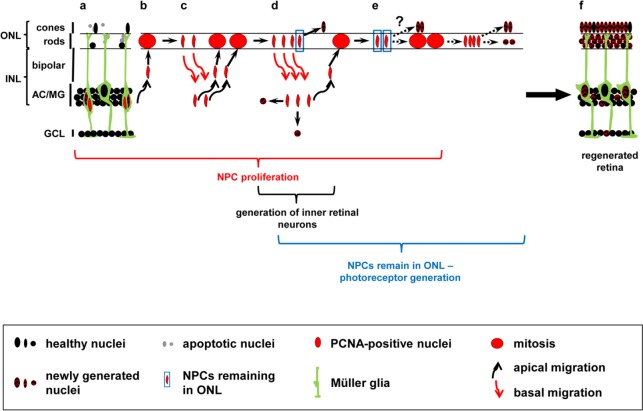Figure 2.
Hypothetical model of NPC-mediated generation of neuronal subtypes in the regenerating zebrafish retina.
Diagram of a light-damaged retina after the initial Müller glia cell division that produced a cell cycle exiting Müller glia (a, checkered nucleus) and an NPC that continues to proliferate (a, red nucleus). NPCs undergo several rounds of cell divisions (b–e), migrating repetitively in phase with the cell cycle between the INL where they replicate their DNA and the ONL where mitosis occurs (b–d, round red nucleus). Black and red arrows indicate apical and basal nuclear migration, respectively. Mitosis potentially produces cells with neurogenic and proliferative fates allowing a subset of cells to sequentially exit the cell cycle (d, e), thereby generating cells that differentiate into the different retinal subtypes. A subset of ONL cell divisions produce nuclei that remain in the ONL (d, e, blue boxed nuclei). These ONL remaining cells could either directly exit the cell cycle and differentiate into the lost photoreceptors (d, e; checkered ONL based nuclei) or undergo an additional cell division before giving rise to photoreceptors (e) resulting in the regeneration of the damaged retina (f). This model is based on the following research: 1) Müller glia divide asymmetrically yielding a cell-cycle exiting Müller glia and an NPC that continues proliferating (Nagashima et al., 2013), 2) only 61 percent of nuclei return from the ONL to the INL after cell division (Lahne et al., 2015), and 3) both photoreceptors and inner retinal neurons are produced following light damage (Vihtelic and Hyde, 2000; Lahne et al., 2015; Powell et al., 2016). The exact sequence of events leading to the differentiation of the different neuronal subtypes in the regenerating zebrafish retina is currently unknown. AC: Amacrine cell; GCL: ganglion cell layer; INL: inner nuclear layer; MG: Müller glia; NPC: neuronal progenitor cell; ONL: outer nuclear layer; PCNA: proliferating cell nuclear antigen.

